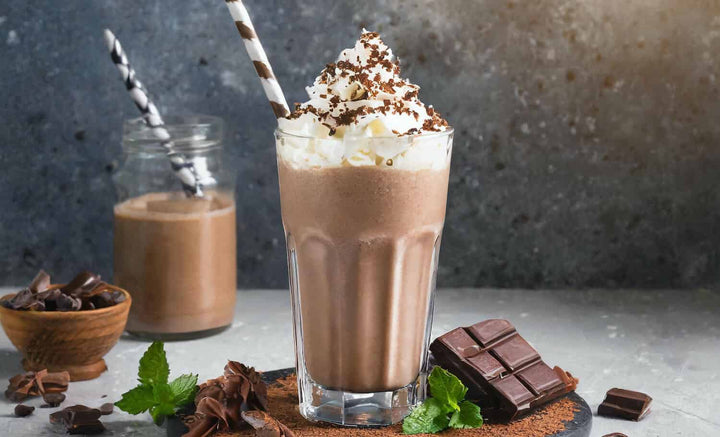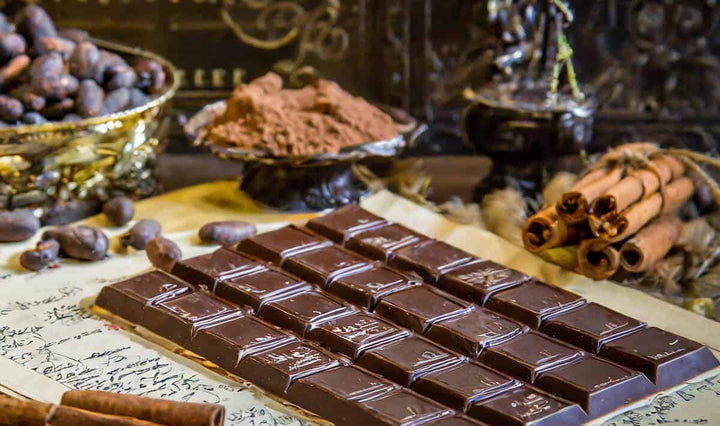You may know the feeling when you reach for some chocolate only to find it's gone grey, bloomed, or melted into an unappetising mess.
Properly stored chocolate not only looks better and lasts longer, but it also tastes more delicious.
So, how exactly should we store chocolate to keep it in its prime condition?
In this post, we'll delve into the world of chocolate storage, sharing tips and techniques to ensure your chocolate remains as tantalising as the moment you bought it.
How To Store Chocolate Long-Term
To store chocolate long-term, it should be kept in a cool, dry place, away from light and any strong odours.
The ideal storage temperature is between 15°C and 18°C.
If your chocolate is wrapped, keep it in its original packaging; otherwise, place it in an airtight container.
For storage beyond six months, you could refrigerate the chocolate, but ensure it's properly sealed to prevent moisture damage and absorption of other food odours.
Before eating, let the chocolate come to room temperature to fully enjoy its flavour.
Related Post: What is Bloomed Chocolate?
How To Store Chocolate in Summer
Storing chocolate in the summer can be a bit tricky due to the warm temperatures. Here are a few tips to help:
-
Keep it Cool: Store your chocolate in the coolest part of your house, away from sunlight and any sources of heat. This might be a pantry, a cellar, or a cupboard that's away from the cooker and other appliances.
-
Airtight Containers: If temperatures in your home exceed 21°C, consider placing your chocolate in an airtight container and storing it in the fridge. Be aware that refrigeration can cause chocolate to 'bloom' (develop a whitish coating) due to sugar or fat crystals rising to the surface, but this doesn't affect the taste or quality.
-
From Fridge to Room Temperature: If you do store your chocolate in the fridge, remember to take it out at least half an hour before eating. This will allow it to warm up to room temperature, enhancing its flavours and texture.
-
Avoid Condensation: When taking chocolate out of the fridge or a cool room, allow it to gradually come to room temperature while still wrapped or in its container to prevent condensation from forming on the surface, which could affect the texture and appearance.
Remember, chocolate is resilient and will retain its quality if stored properly, even in the warmer summer months.
Related Post: Can You Eat Out of Date Chocolate?
Should You Store Chocolate in the Fridge?
While it's not ideal, storing chocolate in the fridge is ok if you're facing warm conditions that could cause the chocolate to melt - usually above 21°C.
The fridge's cool temperatures can help prevent melting, but they can also alter the chocolate's texture and appearance, potentially causing a harmless but unsightly white 'bloom'.
If you do opt for refrigeration, make sure your chocolate is well-wrapped or sealed in an airtight container to prevent it from absorbing other food odours.
When you're ready to enjoy your chocolate, take it out of the fridge and let it gradually return to room temperature before unwrapping.
This will prevent condensation on the chocolate surface, which could also lead to blooming.
In general, it's best to store chocolate in a cool, dry and dark place with good ventilation, ideally between 15°C and 18°C.
But if the weather or your home's heating system makes that impossible, the fridge can be a good plan B.
Related Post: Why Does Chocolate Turn White?
How Long Does Chocolate Last Before It Goes Off?
The shelf life of chocolate can vary depending on the type:
-
Dark Chocolate: Being less perishable due to its low milk content, high-quality dark chocolate can last up to two years if stored properly in a cool, dry place and in an airtight container.
-
Milk Chocolate: Milk chocolate typically lasts about one year. The higher dairy content makes it more susceptible to spoiling over time compared to dark chocolate.
-
White Chocolate: Similar to milk chocolate, white chocolate also tends to last about one year due to its milk and sugar content.
Keep in mind these are general guidelines.
Always check the best-before date on the packaging and remember that chocolate can develop a white or grey 'bloom' over time.
This bloom is harmless and does not mean the chocolate is spoiled.
It's simply a result of sugar or fat crystals rising to the surface.
Finally, if the chocolate develops an off smell, discolouration beyond blooming, or an unusual taste, it's best to err on the side of caution and discard it.
What is the Shelf Life of Chocolate?
The shelf life of chocolate varies based on its type and storage conditions, but generally, it's as follows:
-
Dark Chocolate: Dark chocolate, especially high-quality varieties with a high cocoa content, is more shelf-stable and can last up to two years when stored properly in a cool, dry, dark place.
-
Milk Chocolate: Milk chocolate typically has a shelf life of about one year. Its higher dairy content compared to dark chocolate makes it more susceptible to changes over time.
-
White Chocolate: White chocolate has a shelf life similar to milk chocolate, usually around one year. This is due to its high content of sugar and milk products.
These are just general guidelines, and actual shelf life can depend on the specific ingredients and preservatives in the chocolate.
It's always a good idea to check the "best before" date on the packaging.
Remember, even if chocolate has passed its prime, it often doesn't mean it's spoiled, but rather that it won't taste as good.
However, any off smells, significant discolouration, or mould are signs that the chocolate should be discarded.
Related: How to Make Chocolate Shards Step-by-Step.
Where Can You Buy Top Quality Chocolate?
If you’re on the hunt for delicious and high-quality chocolate, look no further than Whitakers Chocolates.
With a rich heritage stretching back over 130 years, Whitakers is a name synonymous with excellence in chocolate-making in the UK.
What sets Whitakers apart is our secret family recipe, honed to perfection over generations, and our uncompromising commitment to using only the finest and most natural ingredients.
The result is a range of chocolates that not only taste exquisite but are also crafted with great care and attention to detail.
A significant aspect of Whitakers Chocolates is our ethical approach to production.
We fervently promote the use of Fairtrade Cocoa across our range, ensuring that our delicious chocolates also contribute to sustainable development and fair treatment of cocoa farmers.
Adding to our commendable practices, all Whitakers dark chocolate products have secured Vegan certification.
This means that everyone, regardless of dietary preferences or requirements, can savour their quality dark chocolates without compromise.
So, whether you’re a discerning chocolate lover, a keen follower of a vegan lifestyle, or simply someone who appreciates fine food produced ethically, Whitakers Chocolates is a brilliant choice.
Our legacy of quality and commitment to doing the right thing makes us a standout option for anyone looking to enjoy truly excellent dark chocolate.
Here are a couple of our favourite chocolate choices:
- Our original dark chocolate mint wafer thins.
- Milk chocolate 90g bar infused with natural sea salt and smoky caramel flavour.
- Rich dark chocolate fondant creams flavoured with real Raspberry oil.
- Smooth milk chocolate red foiled hearts.
- Milk mint chocolate and honeycomb crisps.
Some Notes From an Expert Chocolatier
As a Master Chocolatier at Whitakers Chocolates with over 130 years of chocolate-making experience, we cannot stress the importance of proper storage for maintaining the quality, texture, and flavour of our chocolates enough.
Throughout our extensive history, we have refined our manufacturing procedures to ensure that every piece of chocolate produced is of the highest quality.
We then maintain this quality by storing our chocolates in a temperature-controlled warehouse facility.
This controlled environment ensures the temperature and humidity levels are kept at optimum conditions, preventing any degradation in the quality of the chocolate before it reaches you.
Our temperature-controlled storage is particularly important in maintaining the glossy sheen and crisp snap of the chocolate, as well as preventing 'blooming', which is the formation of white or greyish streaks and spots on the chocolate caused by changes in fat and sugar crystals.
However, once the chocolate reaches your home, the responsibility of maintaining its quality falls on you.
It's recommended to store it in a cool, dry and dark place, ideally between 15°C and 18°C.
If your home conditions are warmer, you may need to use the fridge, but remember to keep it well-wrapped or sealed to prevent it from absorbing other food odours.
And always let it return to room temperature before unwrapping it for the best taste and texture.
Remember, proper storage doesn't just preserve the life of the chocolate but also its rich flavours, smooth texture, and overall eating pleasure.
Final Notes On How To Store Chocolate
Storing chocolate properly is essential to maintaining its flavour, texture, and quality.
Remember to store your chocolate in a cool, dry, and dark place, ideally between 15°C and 18°C.
In the absence of such conditions, you may use the fridge, ensuring it's well-wrapped or sealed in an airtight container to prevent the absorption of other food odours.
However, do let it return to room temperature before unwrapping to savour its best taste and texture.
If stored properly, chocolate can provide you with a delightful treat long after it's purchased.
Despite these guidelines, always refer to the "best before" date on your chocolate's packaging.











